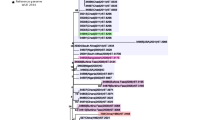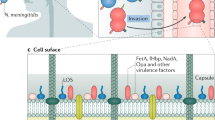Abstract
Neisseria meningitidis is a major cause of bacterial meningitis and septicemia worldwide. In China, serogroup A strains were responsible for over 95% of the cases, while serogroup C strains were only recovered from a few sporadic cases. However, a sudden increase in the number of cases due to serogroup C strains occurred during 2003–2005 in Anhui Province, China. Many cases were found in other provinces at the same time. Multilocus sequence typing (MLST) results indicated that the unique sequence type 4821 clone meningococci, a new hyper-virulent lineage, was responsible for the serogroup C meningitis outbreaks. We have completed the project of sequencing the whole genome of the Chinese N. meningitidis serogroup C representative isolate 053442. We fabricated a whole-genome microarray of N. meningitidis isolate 053442 and analyzed the genome composition differences among 81 serogroup C isolates which were isolated from 14 provinces of China during 1966–2005. The comparative genomic hybridization (CGH) result shows that the genome compositions of nearly all serogroup C isolates are similar to that of 053442. The products of many absent open reading frames (ORFs) are conserved hypothetical proteins. The results will provide a valuable resource from which one can analyze the genome composition and genetic background of serogroup C meningococci in China.
Similar content being viewed by others
References
Stephens D S. Uncloaking the meningococcus: Dynamics of carriage and disease. Lancet, 1999, 353(9157): 941–942
Rosenstein N E, Perkins B A, Stephens D S, et al. Meningococcal disease. N Engl J Med, 2001, 344(18): 1378–1388
Shao Z, Li W, Ren J, et al. Identification of a new Neisseria meningitidis serogroup C clone from Anhui Province, China. Lancet, 2006, 367(9508): 419–423
Davidsen T, Tonjum T. Meningococcal genome dynamics. Nat Rev Microbiol, 2006, 4(1): 11–22
Claus H, Stoevesandt J, Frosch M, et al. Genetic isolation of meningococci of the electrophoretic type 37 complex. J Bacteriol, 2001, 183(8): 2570–2575
Maiden M C, Malorny B, Achtman M. A global gene pool in the neisseriae. Mol Microbiol, 1996, 21(6): 1297–1298
Tzeng Y L, Stephens D S. Epidemiology and pathogenesis of Neisseria meningitidis. Microbes Infect, 2000, 2(6): 687–700
Parkhill J, Achtman M, James K D, et al. Complete DNA sequence of a serogroup A strain of Neisseria meningitidis Z2491. Nature, 2000, 404(6777): 502–506
Tettelin H, Saunders N J, Heidelberg J, et al. Complete genome sequence of Neisseria meningitidis serogroup B strain MC58. Science, 2000, 287(5459): 1809–1815
Peng J P, Zhang X B, Yang J, et al. The use of comparative genomic hybridization to characterize genome dynamics and diversity among the serotypes of Shigella. BMC Genomics, 2006, 7: 218
Kim C C, Joyce E A, Chan K, et al. Improved analytical methods for microarray-based genome-composition analysis. Genome Biol, 2002, 3(11): RESEARCH0065
Perkins-Balding D, Ratliff-Griffin M, Stojiljkovic I. Iron transport systems in Neisseria meningitidis. Microbiol Mol Biol Rev, 2004, 68(1): 154–171
Frosch M, Weisgerber C, Meyer T F. Molecular characterization and expression in Escherichia coli of the gene complex encoding the polysaccharide capsule of Neisseria meningitidis group B. Proc Natl Acad Sci USA, 1989, 86(5): 1669–1673
Hacker J, Blum-Oehler G, Muhldorfer I, et al. Pathogenicity islands of virulent bacteria: structure, function and impact on microbial evolution. Mol Microbiol, 1997, 23(6): 1089–1097
Bille E, Zahar J R, Perrin A, et al. A chromosomally integrated bacteriophage in invasive meningococci. J Exp Med, 2005, 201(12): 1905–1913
Kawai M, Uchiyama I, Kobayashi I. Genome comparison in silico in Neisseria suggests integration of filamentous bacteriophages by their own transposase. DNA Res, 2005, 12(6): 389–401
Selander R K, Caugant D A, Ochman H, et al. Methods of multilocus enzyme electrophoresis for bacterial population genetics and systematics. Appl Environ Microbiol, 1986, 51(5): 873–884
Maiden M C, Bygraves J A, Feil E, et al. Multilocus sequence typing: A portable approach to the identification of clones within populations of pathogenic microorganisms. Proc Natl Acad Sci USA, 1998, 95(6): 3140–3145
Dyet K H, Simmonds R S, Martin D R. Multilocus restriction typing method to predict the sequence type of meningococci. J Clin Microbiol, 2004, 42(4): 1742–1745
Bennett D E, Cafferkey M T. Multilocus restriction typing: A tool for Neisseria meningitidis strain discrimination. J Med Microbiol, 2003, 52(Pt 9): 781–787
Claus H, Maiden M C, Maag R, et al. Many carried meningococci lack the genes required for capsule synthesis and transport. Microbiology, 2002, 148(Pt 6): 1813–1819
Author information
Authors and Affiliations
Corresponding author
Additional information
Supported by the National High Technology Research and development Program from the Ministry of Science and Technology of China (Grant No. 2005BA711A09)
Recommended by Prof. HONG Tao, member of the editorial board of Science in China
Rights and permissions
About this article
Cite this article
Peng, J., Zhang, X., Yang, E. et al. Characterization of serogroup C meningococci isolated from 14 provinces of China during 1966–2005 using comparative genomic hybridization. SCI CHINA SER C 50, 1–6 (2007). https://doi.org/10.1007/s11427-007-0016-2
Received:
Accepted:
Issue Date:
DOI: https://doi.org/10.1007/s11427-007-0016-2




